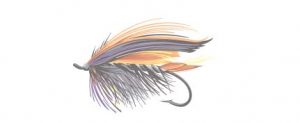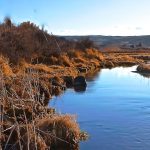April 1, 2013. Much has been written about the reconstruction of the Arkansas River in Pueblo. The structure of a river is one factor that determines how many fish you will find in that river. If fish don’t have rocks, branches, and pools under which to hide, they will not live long.
 In the case of the Arkansas at Pueblo, previous work on the river below the dam had been ineffective resulting in a lack of safe habitat for the fish. The Southern Colorado Greenbacks Trout Unlimited Chapter initiated an improvement project for this stretch of the river by raising over $200,000 and hiring Peter Gallagher from Fin-Up Habitat Consultants. The work involved improving bank stability, sedimentation clean-up, regrading, and the creation of new weirs. Other partners were brought into the fold including the City of Pueblo, CDPW, Excel Energy, Fishing is Fun Grant, Packard Foundation and Cheyenne Mountain Chapter, TU.
In the case of the Arkansas at Pueblo, previous work on the river below the dam had been ineffective resulting in a lack of safe habitat for the fish. The Southern Colorado Greenbacks Trout Unlimited Chapter initiated an improvement project for this stretch of the river by raising over $200,000 and hiring Peter Gallagher from Fin-Up Habitat Consultants. The work involved improving bank stability, sedimentation clean-up, regrading, and the creation of new weirs. Other partners were brought into the fold including the City of Pueblo, CDPW, Excel Energy, Fishing is Fun Grant, Packard Foundation and Cheyenne Mountain Chapter, TU.
 I strategically planned my visit to the Ark at a time when I needed to get back home and restock my camper. Since the river is a relatively short two-hour drive from my house, I could leave early in the morning and get back by dinner and still get in a full day of fishing. I met my guide, Lou McCollough from Steel City Anglers by the Nature and Raptor Center. We meandered through a park-like setting until we got to the river.
I strategically planned my visit to the Ark at a time when I needed to get back home and restock my camper. Since the river is a relatively short two-hour drive from my house, I could leave early in the morning and get back by dinner and still get in a full day of fishing. I met my guide, Lou McCollough from Steel City Anglers by the Nature and Raptor Center. We meandered through a park-like setting until we got to the river.
 During the spring one of the most interesting aspects of a river is the redds or spawning beds. It was exciting to see that some of the stocked fish from previous years had started to form many spawning beds, which look like shallow gravel beds. They get their name from the reddish color that the water takes on due to vibrant red color that the trout turn and then cast through the water. As we walked up the river, we were careful to stay as far away as we could from these beds. Unfortunately, this is not the case with all anglers who are just greedy to catch a fish. In fact it is not illegal to fish in the spawning beds, but it is an unspoken law amongst anglers to leave the fish alone in their spawning grounds. Here’s a great FAQ on Redds. (Photo: http://bit.ly/10uQxPE)
During the spring one of the most interesting aspects of a river is the redds or spawning beds. It was exciting to see that some of the stocked fish from previous years had started to form many spawning beds, which look like shallow gravel beds. They get their name from the reddish color that the water takes on due to vibrant red color that the trout turn and then cast through the water. As we walked up the river, we were careful to stay as far away as we could from these beds. Unfortunately, this is not the case with all anglers who are just greedy to catch a fish. In fact it is not illegal to fish in the spawning beds, but it is an unspoken law amongst anglers to leave the fish alone in their spawning grounds. Here’s a great FAQ on Redds. (Photo: http://bit.ly/10uQxPE)
I have a new grandson and watched the birth of that child during a C-section on video, which I found both miraculous and mysterious. Perhaps that inspired my intrigue with a trout’s life cycle. When I researched this, I discovered that In the wild, most varieties of rainbows spawn in the spring. Before spawning, males undergo astounding anatomical changes. A male’s jaws lengthen and the lower jaw develops a kype, which they use to fight off other fish intruding on their territory. In addition, the spots on all fish become more prominent and the pink stripe becomes more intense in color.
The female digs several redds for depositing the eggs by turning on her side and beating her tail against the bottom, moving the gravel away to create a depression longer than her body and about half as deep. The male and female lie side by side and release milt and eggs. The amazing statistic here is that fewer than one percent of the newly hatched “fry” survive their first year. (Ah ha! Now I know where “small fry” comes from!) I think of how unusual it is in the 21st century for humans to lose our children. In the 18th century in France, only 50% of the children lived to be 10 years old and in the mid 19th century in Germany, 30% of all children born died before their first birthday. (http://bit.ly/Z6zv8f)
Guess I’m saying that I’m grateful to have all my children and grandchildren even with all the challenges that it presents.





